COMIC BOOK DRAMA UNLEASHED MORE HEATED DEBATES ABOUT ART
AMBER LOVE 21-OCT-2016 I’m not an artist. I am, however, a model for a lot of artists. Some of them are in comics, but mostly not. Nonetheless, my experiences as a model for probably over a hundred different people throughout the years means that I have some base of knowledge to speak about gaze, representation, styles, and definitions of sexualization.
CORPORATE DECISIONS AREN’T CENSORSHIP
There’s a lot of debate about comic book art these days. It’s not because there’s never been an issue before social media; it’s always been there. We can look back at the awful stylization of characters in the 1990s to see exaggerated male and female forms that some bordered on sickening (objectively speaking). Teeny waists. Broken back poses. Cleavage that would topple a real person. People pick on Barbie’s measurements all the time, but if you dare approach criticism in comics, you’ll be harassed and accused of “censorship.”
The ACLU is obviously a top choice in organizations to discuss First Amendment rights. I’ll give this side of the debate its due only to show how it’s not at all relevant.
“Censorship, the suppression of words, images, or ideas that are “offensive,” happens whenever some people succeed in imposing their personal political or moral values on others. Censorship can be carried out by the government as well as private pressure groups. Censorship by the government is unconstitutional.” @ACLU. “What Is Censorship?” American Civil Liberties Union. N.p., n.d. Web. 21 Oct. 2016.
When an artist is hired by a company to create an image, they do not have free reign nor First Amendment protection. In other words, they have a client to answer to. On a bigger scale, they have a lot of people to answer to. The government hasn’t intervened with comics since Frederick Wertham and the Comics Code Authority.
Work for hire artists have responsibilities to:
- their editors
- publishers
- copyright/trademark holders
- the legacy of a franchise
- the audience
- the fans (not the same thing as audience)
- the retailers who are going to be carrying the product
Now let’s acknowledge the clause, “as well as private pressure groups.” This is actually valid though it can be mired. There’s no organized group of women meeting Wednesday nights who talk about the offensive comics on the shelves. Not that I’m aware of anyway. Go ask Tipper Gore. Maybe she knows where they meet.
The viral nature of social media and the prevalence of multi-contributor blog sites can give the appearance of a private group applying pressure. Such was the case when The Mary Sue website said they would no longer cover the promotional aspects of GAME OF THRONES though they would allow contributors to write episode recaps.
In a nutshell, when it comes to these controversial comic book covers, there is no singular group applying pressure to have them pulled from market. There are individuals who voice their concerns through social media and then the PUBLISHERS make the decision whether or not to pull them from production.
We’ve seen the most heated debates come from criticism over covers of TEEN TITANS, SPIDER-WOMAN, WONDER WOMAN, and the new IRON MAN “Riri Williams aka Iron Heart”. Artists will defend themselves, especially when hired on variant covers that are not the default product a comic reader would get; normally something along of the lines of, “If you don’t like, don’t buy it.” I can respect that to a degree. It’s generally how I take action. Though sometimes, as someone who writes critically about the market, if I don’t have a press copy, I need to spend the dollars to get a product in order to analyze it. In such cases, I’ll usually take the path of research instead which entails scouring articles for the source images and reading other people’s opinions.
You don’t get to decide whether someone else is offended.
A corporation’s decision to pull a book or a cover variant is not censorship. With the case of the BATGIRL Joker variant, that decision came from the artist and the publisher mutually after hearing from the regular creative team on the book and the fans. I think it was a wise move to listen to what people had to say and spend time thinking about it. DC didn’t make these decisions within seconds of seeing Twitter storms. There were a bunch of people involved and time given to mull over the decision. With the case of the WONDER WOMAN Frank Cho variant, that was a debacle of miscommunication about who was in charge of the final product. The latest is on Marvel’s plate, the Riri Williams INVINCIBLE IRON MAN exclusive variant for only Midtown Comics.
BEAUTY IDEALS
There are usually discussion panels (at comic conventions that have the wherewithal to invite female creators as guests) about the representation and imagery of female characters in comics or games. “Sexy vs Sexualization,” was the theme of one I saw in New York one year. I believe it had such legendary creators as Jenny Frison, Emanuela Lupacchino, Marguerite Bennett, Gail Simone and Amy Reeder (Reimagining the Female Hero).
There are organizations across the globe dedicated to bringing awareness about the damaging fallout of artificial beauty ideals, most especially in advertising. There’s tremendous pushback against Photoshopping already thin models. Today’s most prominent celebrities like Kerry Washington and Beyoncé have taken a stand against the tradition that “beautiful” means thin, white/light, and “Becky with the good hair.” Seventeen Magazine has taken the steps to cut back on Photoshopping.
You can be responsible and Google the thousands of articles that address the damage on young girls and women of all ages on seeing these artificial Western ideals that are impossible to achieve. I’m not here to do your homework for you.
There are controversies when adult age celebrities like Jessica Biel or the cast from GLEE do magazine shoots that are racy and sexy because they are cast as teenage girls. The audience perception and the marketability of the products being sold (i.e. the fictional characters of the shows) are conflated with who the women are in real life.
Here are my own examples of looks that I was going for while cosplaying as Wonder Woman from DC Comics, property of Warner Brothers.
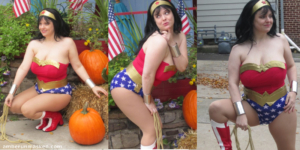
Now, let me take it one step further (it’s a big step!). Here’s where we get into the debates about art like that of Frank Cho, known not only for comics but also for pinup art and his book on how to draw and paint beautiful women. I’m a huge fan of Cho’s art, but I understand commercialization and context. You can’t show Wonder Woman’s underwear showing on a book revering the strongest female heroine of DC Comics. And YES, underwear is different than the “bathing suit” costume. It’s underwear. It’s not meant to be seen unless intentionally shown off which is why “upskirt” images of Supergirl are gross.
This is what sexualized for the male gaze looks like:
And this is what mature-rated sexualized parody looks like:
WHY IS RIRI WILLIAMS CONTROVERSIAL?
The J. Scott Campbell variant cover commissioned as work for hire by Marvel exclusively for Midtown Comics is one of the most controversial for several reasons.
1. RACE
The race of the character means the imagery of her will be scrutinized differently. Viewers will be unconsciously absorbing messages that they wouldn’t from an image of a white male figure. If you haven’t done any homework (listened to women of color online calling this out, you need to), black and Asian girls face more fetishization and objectification than white girls. You might not understand that it’s because of hundreds of years of men finding non-white women “exotic” or “taboo” and therefore things to be desired, craved, or owned.
2. AGE OF THE CHARACTER
She’s supposed to be 15 years old. In the cover that was promoted when the character was first announced, she was stunning for sure and a welcome addition to the Marvel fanbase because they lack black women as characters and as creators. It was a big deal. But on that INVINCIBLE IRON MAN cover, she doesn’t look 15. She also doesn’t look 15 on the Campbell variant. The aging up of the character is one of the things that pushes it into imagery for the adult male gaze. I talked about aging characters appropriately in comic book art with Michael Lark of LAZARUS back in 2014 on Vodka O’Clock.
3. SKIN COLORING
All artists have their own interpretations, styles, and comfort zones. I don’t know if Campbell colored the variant he did, but the skin color is many shades lighter than the initial promo image released. In fact, none of the images are consistent. This brings back the arguments that beauty ideals are unconsciously shifted to a Western definition. “If you can’t be white, you need to be light,” is the saying for actors. Producers, artists, creators of content in general, may not even realize that they’re doing this. Take a look at the 2014 Dove ad where “dirty” was on one side and “clean” on the other; Dove, a proponent of diversity that fails often, put the black woman on the “dirty” side of the spectrum and the white woman on the “clean” side. Again, they probably didn’t mean to make that correlation, but it happened. They’ve also been criticized for using the word “normal” to mean “straight” for hair care products as if “curly” was somehow “abnormal.”
4. THE FASHION STYLE
Riri’s low riding pants haven’t been popular since Britney Spears and Christina Aguilera were turning legal age. Pop stars are probably only second to fashion models when it comes to sexualization of underage girls and exploitation. Because Campbell’s style is to elongate figures, it looks like those pants are barely able to cover the pubic bone. The eyes of viewers are going to be drawn to the sections of bare skin whether it’s a midriff or exposed neckline or thongs going up butt cheeks.
If you’re hired to draw a 15 year old girl, check out what they’re wearing and how it needs to translate into the superhero or scifi story. Riri is a genius. Maybe she’s be wearing coveralls and welding goggles especially if she’s in a garage or lab. The hoodie and sneakers are great examples for what a kid would wear to school.
The hair? Well, I have no idea why that changed. When the first image came out where Riri has the darkest skin and the biggest afro, people criticized that awkward part in her hair on the side. She’s not Moss from the IT Crowd.
5. THE CHARACTER’S BODY SHAPE
Changing the style of the art means the body shape will probably change too. As a model, I’ve gone around the room and taken it all in how each pair of eyes sees me differently. If camera lenses are guilty of this, of course humans are.
I first saw this gif when tweeted by comic book creator Jim Zub, but I don’t know who the original source is. Below is an example of what five different artists of various experience levels created when I was in a pose. You’d easily expect differences because of where they were in the room, but there’s also a huge variation in style.
As I said before, it is Campbell’s style to elongate. He’s certainly not the only artist who does it. In comics it can be hard to see differences in characters other than their hair and costumes. Some of that is because artists get comfortable drawing a certain shape figure and face. All Campbell’s women are going to have the exact same nose. Just like Michael Turner did before him. Just like almost all mainstream, superhero artists. Same boobs. Same eyes. Same insanely tiny waists that make Barbie look fat.
Where people are being asked to listen is when, “Oh, that’s just the artist’s style,” is used as a defense. YOU CAN HAVE A STYLE. But you still need to represent the characters as unique creations. Frank Cho’s Wonder Woman does not look like Frank Cho’s She-Hulk nor like Frank Cho’s Harley Quinn. He has “his” style, but he draws the characters as individual beings.
6. THE POSE
This is one argument where I side with the defenders of the Campbell cover. I don’t see this pose is sexualized, in and of itself. The hip popping is sometimes more comfortable depending on a person’s structure and strength. I don’t stand equally grounded through both legs when I pose. I always lean more heavily on one side, usually my right. It’s the Q-angle of my hips to knees and whether or not my waist is twisted that will alter how wide or thin I look. However, I can easily acquiesce that the pose is just “one more thing” in the mix so it can’t be ignored.
7. TARGET DEMOGRAPHICS
Just like we went through with the BATGIRL debates, there’s recognition that women read comics too. And women and young girls want comics they feel comfortable reading. They don’t want to feel like unicorns going to a comic shop or convention. They want their share of the market. These companies know it’s good business to sell to women.
So here we are again. Top publisher with a comic about a young female lead. We want to be joyous! We want to celebrate this even though it’s taken too damn long!
To conclude about the Campbell Riri cover, it was Midtown Comics and the publisher Marvel Comics that decided to pull the variant. It’s their position to make that call as the B2B customer of the exclusive variant and the corporation in charge of the property. If they weighed all these factors, it seems like a responsible move.
UPDATE:
To show that some of the stores had better vision and worked more collaboratively with variant cover artists, here’s what Randy Green did for Ariel Johnson, the owner of a comic shop cafe in Philly called Amalgam. Green created something that shows women enjoying each other’s company, a black female business owner, a black female superhero on a break, and even with bare midriffs he placed them so that’s not the focus of the picture. Well done!

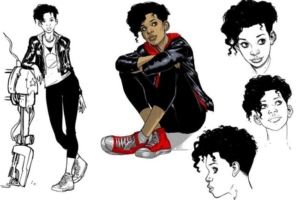
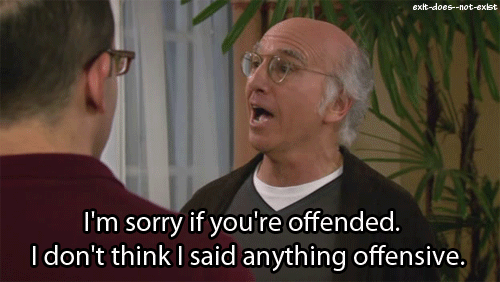
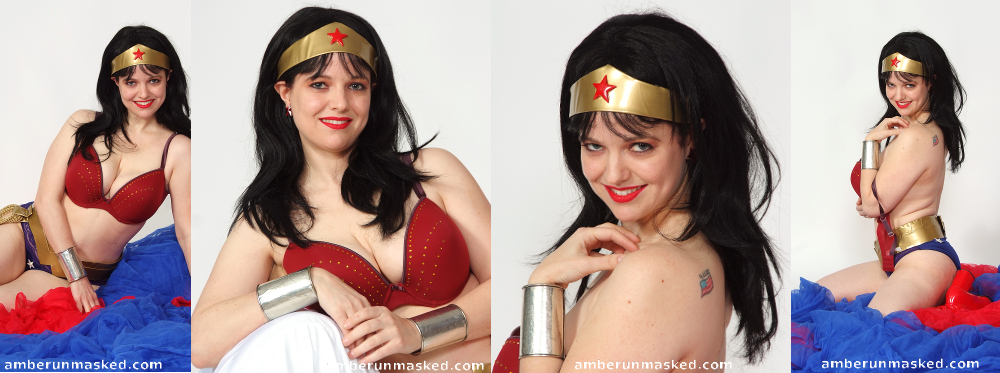
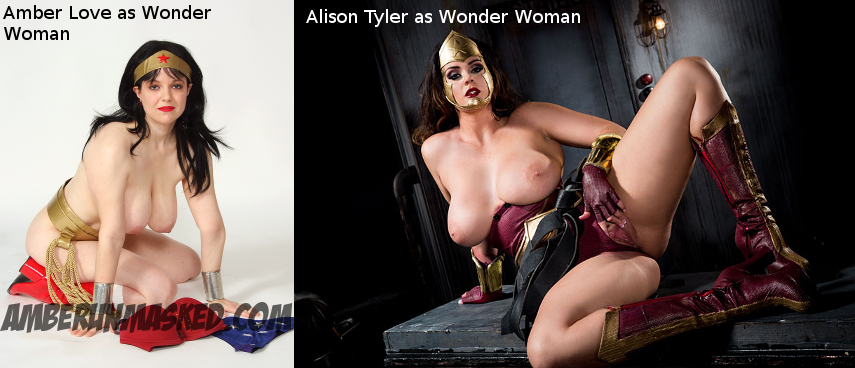
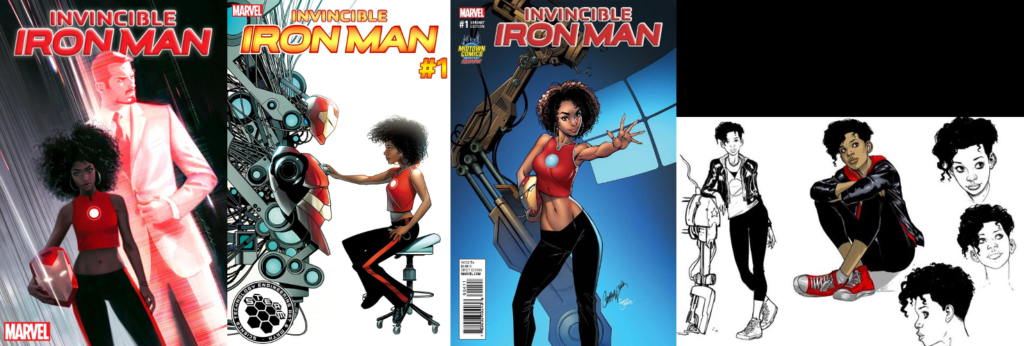
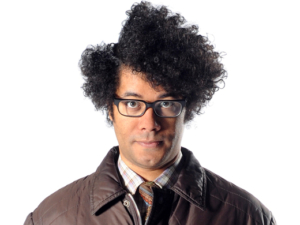
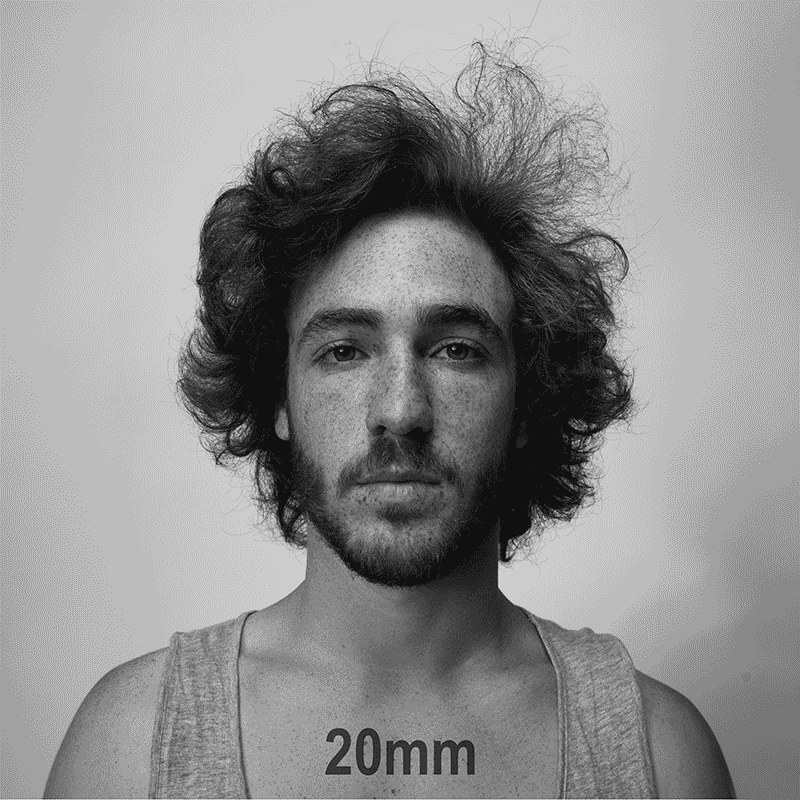
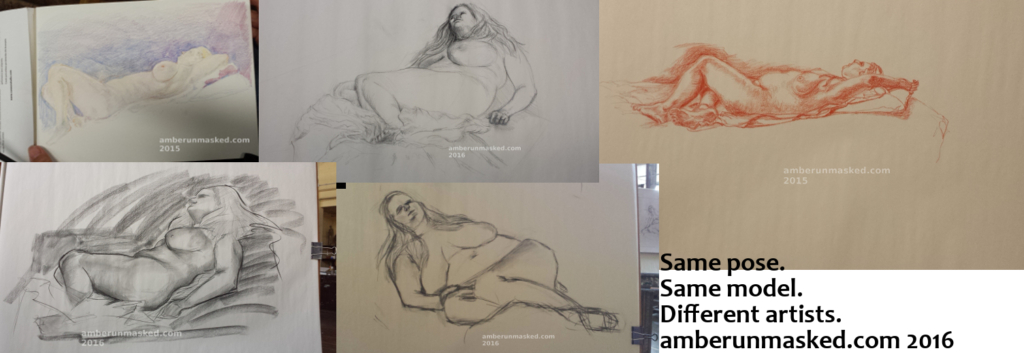
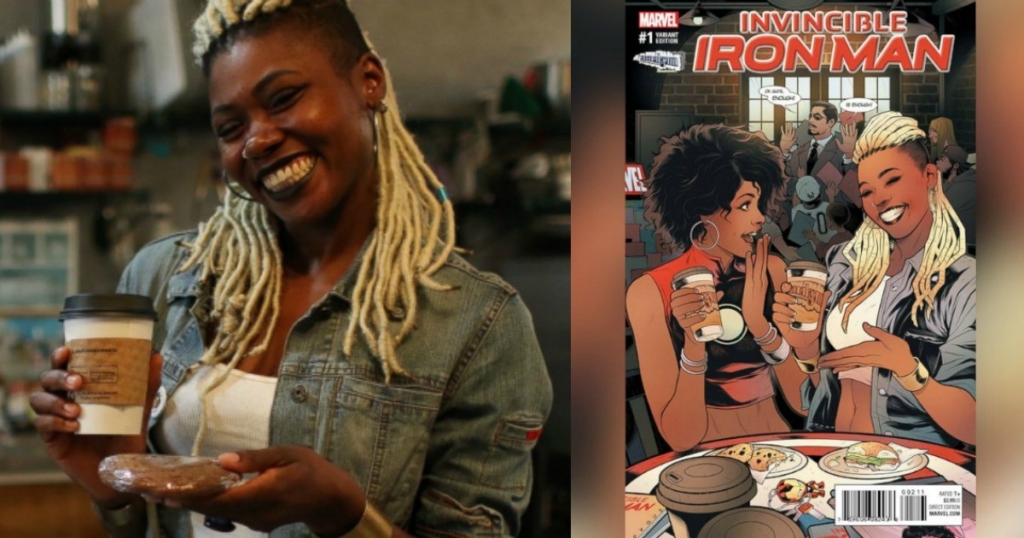
1 Comment on Artistic style vs commercial representation of women (some NSFW images) (updated)
Comments are closed.